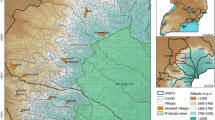Abstract
The Kingdom of Nepal extends 800 km east to west along the southern slopes of the Himalayas. Because of its biogeographical position, Nepal contains biological elements of both the Indo-Malayan and Palaearctic realms. Beside the trees in forest ecosystems, a large number of tree species are maintained on farms as part of subsistence farming systems. The role of these trees in ensuring the sustainability of agricultural production and the importance of traditional farming systems for the conservation of crop diversity have been well documented. However, the status of farm trees and their role in biodiversity conservation are poorly documented. This paper presents a case study of two villages in the western middle hills of Nepal. It highlights the role of traditional agroforestry practices for the conservation of tree diversity and argues that farms can be considered biodiversity reservoirs. Farm trees help to reduce pressure on community and government forests and create a favorable environment for many plant and animal species. Farm trees also provide social functions in that households with many farm trees no longer exercise their communal rights to extract grass products from community forests, which in turn benefits poor and disadvantaged households. The paper discusses possibilities to improve the role of farm trees in biodiversity conservation. It argues for the development of mechanisms such as tax exemptions and conservation credits that provide benefits to rural communities as compensation for their local and global environmental services including biodiversity conservation.
Similar content being viewed by others
Abbreviations
- BPPN:
-
Biodiversity Profile Project, Nepal
- CBS:
-
Central Bureau of Statistics
- HH:
-
Households
- HMGN:
-
His Majesty's Government of Nepal
- LRMP:
-
Land Resources Mapping Project
- LSU:
-
Livestock Unit
- NBS:
-
Nepal Biodiversity Strategy
- R:
-
Species Richness Index
- SDI:
-
Species Diversity Index
- VDC:
-
Village Development Committee
References
K.P. Acharya B.N. Oli (2004) ArticleTitleImpacts of community forestry in rural livelihoods of midhills of Nepal: a case study from Bharkhore community forest, Parbat District Banko Janakari 14 46–50
Acharya K.P., Gautam K. and Acharya B. 2004. The Impacts of Forest Management in Community Forestry on Biodiversity: A Case Study from Mid Hills. Forest Research Leaflet no 18. Department of Forest Research and Survey, Kathmandu, Nepal.
BPPN. 1996. An Assessment of the Representation of the Terrestrial Ecosystems within the Protected Areas System of Nepal. Biodiversity Profile ProjectNepal, Publication No 15. Ministry of Forests and Soil Conservation, Kathmandu, Nepal.
Carter A.S. 1991. Tree Cultivation on Private Land in the Middle Hills of Nepal: A Village Perspective. D.Phil. Thesis, Linacre College, Oxford, UK.
A.S. Carter D.A. Gilmour (1989) ArticleTitleIncrease in tree cover on private farmland in Central Nepal Mount. Res. Develop. 9 381–391
InstitutionalAuthorNameCBS. (2001) Population Census Main Report Central Bureau of Statistics Kathmandu, Nepal
A.N. Das (1999) Socio-economics of Bamboos in Eastern Nepal Aberdeen University UK
P.F. Fonzen E. Oberholzer (1984) ArticleTitleUse of Multipurpose trees in hill farming systems in Western Nepal Agrofor. Syst. 2 197–197
Gautam K.H. 1986. Private Planting: Forestry Practices outside the Forest by Rural People. Forestry Research Paper Series no 1. HMG/USAID/GTZ/IDRC/FORD/Winrock Project, Kathmandu, Nepal.
D.A. Gilmour R.J. Fisher (1991) Villagers, Forest and Foresters: The Philosophy, Process and Practice of Community Forestry in Nepal Sahayogi Press Kathmandu, Nepal
InstitutionalAuthorNameHMGN. (2002) Nepal Biodiversity Strategy Ministry of Forests and Soil Conservation Kathmandu, Nepal
P.P. Jha K.K. Shrestha M.P. Upadhyay D.P. Stimart D.M. Spponer (1996) ArticleTitlePlant genetic resources of Nepal: a guide for plant breeders of agricultural, horticultural and forestry crops Euphytica 87 189–210 Occurrence Handle10.1007/BF00023747
Joshi K.D., Subedi M., Khadayat K.B. and Staphit B.R. 1996. Genetic diversity and erosion in indigenous arable crops and green manuring species in the mountains of Nepal: some conservation issues. Paper presented at the workshop on Managing Agricultural Biodiversity for Sustainable Mountain Agriculture: Issues and Experiences, LI-BIRD/ICIMOD/IPGRI, Nepal.
Kharal D. 2000. Diversity and Dynamics of Trees Species and its Sustainability in the Rural Farm Land: A Case Study in Chitawan Districts in Nepal. M.Sc. Thesis, The Agricultural University of Norway, Norway.
InstitutionalAuthorNameLRMP (Land Resource Mapping Project) (1986) Summary ReportHMGN/Government of Canada Kenting Earth Sciences Limited Kathmandu, Nepal
Mahat T.B.S. 1987. Forestry-Farming Linkages in the Mountains. ICIMOD Occasional Paper No. 7, Kathmandu, Nepal.
Malla Y.B. and Fisher R.J. 1988. Planting trees on private farmland in Nepal: the equity aspect. Proceedings of an International Workshop on Multipurpose Trees for Small Farm UseThailand. Winrock International Institute of Agricultural DevelopmentUSA/IDRC, Canada.
R. Margalef (1969) ArticleTitleDiversity and stability: a practical proposal and a model of interdependence Brookhaven Sympos. Biol. 22 25–37 Occurrence Handle1:STN:280:CS%2BC38jltFU%3D Occurrence Handle5372794
P.J. Robinson (1986) The dependency of crop production on trees and forest land R. Prinsley (Eds) Amelioration of Soil by Trees Commonwealth Science Council London, UK 99–115
Rusten E.P. 1989. An Investigation of an Indigenous Knowledge System and Management Practices of Tree Fodder Resources in the Middle Hills of Central Nepal. Ph.D. Thesis, Michigan State University, USA.
C.E. Shannon W. Weaver (1949) The Mathematical Theory of Communication University of Illinois Press UrbanaIllinois, USA
T.B. Shrestha R.M. Joshi (1996) RareEndemic and Endangered Plants of Nepal WWF Nepal Programme Kathmandu, Nepal
Author information
Authors and Affiliations
Corresponding author
Rights and permissions
About this article
Cite this article
Acharya, K.P. Linking Trees on Farms with Biodiversity Conservation in Subsistence Farming Systems in Nepal. Biodivers Conserv 15, 631–646 (2006). https://doi.org/10.1007/s10531-005-2091-7
Received:
Accepted:
Issue Date:
DOI: https://doi.org/10.1007/s10531-005-2091-7




